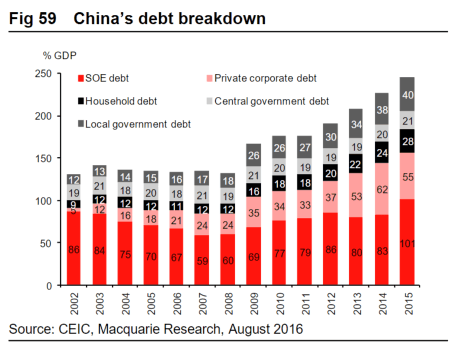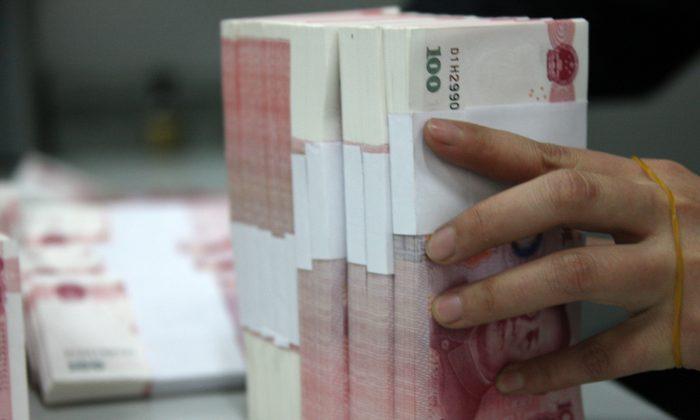For years the world has marveled at China’s foreign exchange reserves ($4 trillion at their peak in 2014) and low government debt, 21 percent of GDP at the end of 2015.
This is about to change, however, as fiscal spending was up 15.1 percent in the first half of 2016 to counter a slowing economy and achieve the official GDP growth target.
“China’s growth rebound in the first half of this year has been strongly supported by an active fiscal policy that has significantly front-loaded on-budget spending and fostered strong growth in off-budget investment in infrastructure,” Goldman Sachs wrote in a note to clients.

The state says the deficit on this year’s budget is only about 3 percent of GDP. Some central bankers want to boost it to 5 percent because they think monetary policy alone won’t be able to hold the economy together.
Also, people are starting to look at Chinese government debt differently. According to Goldman Sachs estimates, China’s total fiscal deficit is approaching 15 percent rather than 3 or 5 percent.
“We try to ‘augment’ the official fiscal policy measures by incorporating off-budget quasi-fiscal policy to obtain a comprehensive picture of the stance of China’s fiscal authority,” Goldman Sachs wrote.

China’s total fiscal deficit according to Goldman Sachs calculations. (Goldman Sachs)
To get to the 15 percent, Goldman looks at infrastructure spending in total, which is driven by the central government, State-Owned Enterprises (SOEs), or local governments. SOEs are in debt to the tune of 101 percent of GDP, and local governments through their off-balance-sheet finance vehicles have about 40 percent of GDP.
“Specifically, we sum up the fixed asset investment in sectors such as transport, storage, and postal service, and water conservancy, environment and utility management. We assume most of the spending in these sectors is heavily state-driven,” the bank wrote, noting that the analysis is not complete but provides a good proxy.

The theory holds up when looking at charts of fixed asset investment by the state sector, which zoomed ahead at the beginning of the year but has recently pulled back.
Public Private Partnerships
Because investment by private companies has turned negative, the regime is trying to continue fiscal stimulus and get the private sector involved through so-called public-private partnerships (PPPs).
According to state-run Xinhua, China wants to fund 9,285 projects worth $1.6 trillion in infrastructure projects such as transportation or public facilities like sports stadiums. According to the National Development and Reform Commission (NDRC), $151 billion of these projects have been signed at the end of July 2016.
Investment bank Morgan Stanley doesn’t think the initiatives will succeed, however.
“We expect PPP to have limited impact on China’s investment growth, considering the small size of PPP projects in execution, still low private participation, and weaker [credit] growth,” Morgan Stanley wrote in a note.
So it looks like SOEs will have to do the heavy lifting again, despite mounting bankruptcies and abysmal returns on investment.
“SOEs are also central to the issue of over-capacity. According to an official survey, the average capacity utilization ratio in the manufacturing sector was 66.6 percent in 2015, declining by 4.4 percentage points compared to 2014. Most of the sectors facing over-capacity issues are dominated by SOEs, such as steel and coal,” Goldman Sachs wrote.
Worth Wray, the chief strategist at STA Wealth Management, thinks short-term motives could be behind the burst in spending this year.
“If this is about buying time, until after the G20 meeting in September, after the yuan’s inclusion in the International Monetary Fund (IMF) reserve currency basket in October, and after the U.S. presidential election in November, then I can understand why massive fiscal and credit stimulus in 2016 could make sense,” Wray said via Twitter.
Long-term, however, this strategy won’t be sustainable, according to Wray: “If they are trying to resist a debt-induced slowdown with more debt and by wasting room on the central government’s balance sheet, I’m afraid China is heading for a fate worse than Japan.”
So will the spending spree continue? Goldman says yes—the government wants to hit its official GDP target for 2016.





